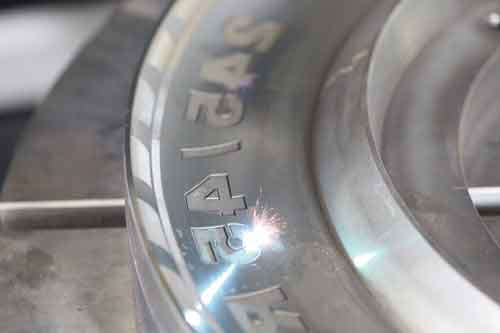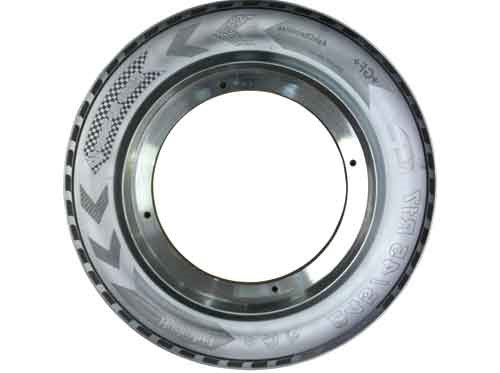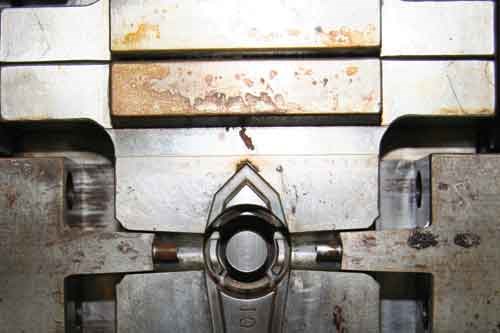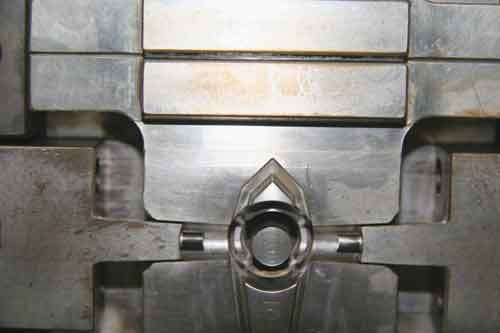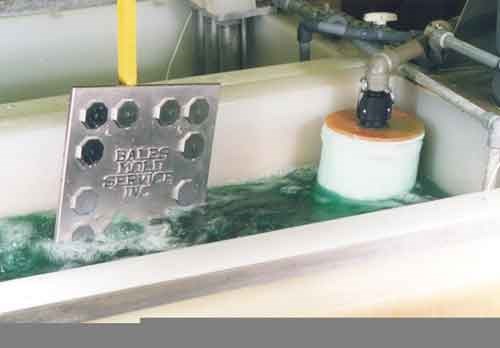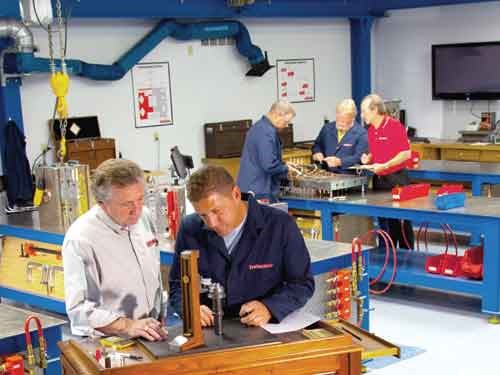Keeping Molds Running
Technology advancements encourage moldmakers to think about surface treatment, mold maintenance and repair issues earlier in the mold build process to obtain better mold performance and life.
Welding. Cleaners. Ablation. Tracking. Heat Treating. Lasers. Finishing. Preventatives. Plating. All of these terms refer to measures and processes mold manufacturers must apply to molds to ready them for their customers. In terms of surface treatment, proper treatment of the mold’s surface is paramount to its quality, corrosion-resistance, wear and tool life. And, mold maintenance and repair are key to keeping a mold running.
A variety of manufacturers and suppliers from the aforementioned categories weigh in on the questions they are most commonly asked as well as advancements and trends in both the surface treatment, and mold maintenance and repair segments.
Surface Treatment
Laser Texturing
Some common questions that Gisbert Ledvon, Director of Business Development for GF AgieCharmilles North America (Lincolnshire, IL)—a manufacturer of laser texturing, milling and EDM equipment—receives include: can laser texturing perform mold insert repairs; and what are the limitations of laser texturing? When, answering these questions, Ledvon notes that laser texturing systems can repair mold inserts. “However, in order to be successful, moldmakers need to ensure their welded material has the same material properties as the rest of the original mold,” he explains. “With that, the laser texturing process can repeat the same surface finish and texturing in the repair application.”
Ledvon points out that as surface texture becomes an important aspect of product design for many industries, moldmakers are increasingly seeking out ways to improve the level of control exerted in the surface texturing process. “Fairly recently, laser texturing technology has emerged to replace chemical etching and provide improved accuracy, consistency and quality,” Ledvon states. “After all, it is impossible to precisely control the texture produced in chemical etching. With laser texturing, the laser sublimates the material, or turns it directly from a solid to a gas. Laser texturing systems can be equipped with pulsed, fiber-optic lasers of varying strengths and a variety of lenses with different focal lengths to maximize productivity.”
The most common question Precision Laser Technology (Rochester, NY)—a provider of laser welding services—receives relative to laser texturing concerns the types of finishes the company can provide, notes Co-owner Ron Natale. “As laser etching capabilities are digitally driven, we can either create or match most industry standard EDM and texture finishes by use of proprietary software and algorithms,” Natale elaborates. “However, the greatest advantage is the ability to combine laser texturing capabilities within engraving cycles. For example, an insert having complex features—constricted text, elaborate graphics and one or two surface finishes—would encompass a series of four or five electrodes. We can produce all of the etching details in a single cycle, helping to reduce costs and improve deliveries.”
When it comes to limitations, the only real restrictions of laser texturing involve the depths of the texturing and the machining time required for very large surface finishes, Ledvon maintains. “With respect to cavity detail depth, the ratio of cost and performance rule of thumb is 3:1,” he comments. “In other words, a texture detail 1 mm wide can only be cut 3 mm deep, which may pose a problem when imparting smaller cavity details they have to be deeper. Where machining time is concerned, laser texturing takes longer than chemical etching. Keep in mind, with laser texturing, shops can run the process completely unattended, which is not the case with chemical etching. However, moldmakers working with large surfaces stand to benefit from reduced setup and preparation time by using both laser texturing and chemical etching.”
According to Ledvon, laser technology has significantly advanced within just the past five years. “The biggest enhancement involves the laser source itself, meaning fiber lasers are much more efficient and have a longer lifespan than previous designs,” he says. “For this year, I think even more is going to be done to optimize these laser sources. More specifically, I think there will be different types of lasers, including larger machines, which provide better cutting performance and/or deeper cavities to accommodate specific application requirements.”
The company recently introduced what Ledvon calls the world’s largest laser texturing machine that adds “unique and various textures to oversized molds for a wide range of components, including bumpers, instrument panels, door panels, central consoles and airbag covers for the automotive industry and others also working with large components.”
Rust Preventatives
For surface treatments, one item that moldmakers and molders have asked about for years is a rust preventive formulation that would be safe to use on molds used to process food parts, notes Michael Muth of Slide Products, Inc. (Wheeling, IL) —a manufacturer of rust preventatives and mold cleaners. To that end, the company has introduced products that have been approved by NSF International (an independent, not-for-profit organization that provides standards development, product certification, auditing, education and risk management for public health and the environment) for use on food-related mold surfaces.
Plating/Coating
Engineered coatings and finishes provider Bales Mold Service, Inc. (Downers Grove, IL) receives questions from customers every day, Technical Sales Manager Harry Raimondi notes. Some of the most commonly asked include: what coating is available to help release parts or protect the mold from corrosion? How can I protect my mold from galling? What is the best coating for PVC? I am molding a clear part with little to no draft that needs protection and release. What are my options?
According to Raimondi, new chemistries are being developed in the industry that will enable suppliers to offer more coatings based on the customer’s needs. “It is our belief that these coatings, when they are available, will cause mold designers and builders to think about and incorporate their coatings requirements earlier in the mold building process,” he says. “It will become clear that the sooner vendors know those requirements, the faster and better we can provide solutions that meet their needs.”
Mold Maintenance/Repair
Laser Welding
Moldmakers have a number of questions for those manufacturers and suppliers of laser welding equipment and services. John Demakis, Sales and Marketing, Alliance Laser Sales (Wauconda, IL)—a provider of a number of services including laser welding, mold finishing and polishing—points out that the number one question he gets is, “Can we get in there to weld it? In most cases the answer is, yes.”
Natale of Precision Laser weighs in. “The most common question, regardless of quantity, complexity and cost, is “How quickly can I have my mold back?” he states.
Over at laser equipment manufacturer LaserStar Technologies Corp. (Riverside, RI), Senior Applications Engineer Todd Deslauriers points out that questions he receives center around laser versus TIG welding. “Moldmakers want to know the advantages of using lasers to repair molds versus TIG welding. I explain that lasers will produce less of a heat-affected zone (HAZ) and this is important to prevent heating issues within the mold—avoiding creating carbon pockets or stressing the mold.”
Scott Phipps, President of United Tool & Mold, Inc. (UTM; Easley, SC)—mold manufacturer with niche specialty in mold repair; and 2011 MoldMaking Technology Leadtime Leader Award Winner—agrees that laser welding is becoming more prevalent. “Laser welding is something that is being requested more from the customer base, because it is easier on molds than traditional welding methods.”
Natale adds, “By utilizing laser technology and automated machinery, we can limit the necessary rework of a mold and offer more time for re-qualification and molding. Our technology and equipment provide controlled weldment of 0.005” into deep cavitation and narrow mold areas with minimal heat induction and sink. For complex, highly constructed molds, precision control welds can be applied without affecting other mold features.”
Demakis of Alliance Laser Sales is seeing the emergence of wire feed for lasers. “I see it being used on all types of surface coatings and applications,” he elaborates. “One example would be to use one steel for heat transfer, weld another material for hardness with one application. Add to that the fact that our machines are able to run CNC, it makes a lot of things possible.”
As far as advancements, Deslauriers of LaserStar Technologies notes as lasers become more common in facilities that deal with molds the more the technology becomes a standard. “In the past, lasers were seen as a luxury or a wish list item,” he says. “As many companies are spending more and more money sending molds out to vendors for repairs they see the benefit of having a laser in-house to perform the mold repairs.”
Education and Training
Steve Johnson, Operations Manager at ToolingDocs (Ashland, OH)—a provider of mold maintenance certification training—says that moldmakers are asking if there is training available for their staff since many are now engaged with offering mold repair as an additional service to their customers, as well as just needing their molds to be maintained.
“Once designated a Certified Maintenance Provider (CMP), moldmakers can demonstrate to customers that their tool repair department runs to an industry best practices level—which helps everyone,” Johnson notes. “While mold building and mold repair skills may occasionally cross-over, the two require different skill sets when operating as a day-to-day business versus a situation where mold repair is more of an occasional customer service.”
Johnson sees shops operating in a more systemized fashion that includes collecting and using standardized shop terms that allow mold repair and maintenance issues to be better tracked and acted upon. “Historically, mold maintenance has always been left up to one’s ‘best guy’ to do whatever was necessary to get a mold back up and running,” he comments. “In today’s leaner shop environment, all repair techs and managers need to be operating in the same system as opposed to everyone doing their own thing where data and bench practices vary day to day and person to person.”
All of those aforementioned professionals will be empowered with the most useful tool of all: accurate maintenance data, Johnson continues. He believes having access to historical data that can be looked at in various ways—depending upon one’s job and what one wants to know—provides huge insight into how molds can be better designed, built and run.
ToolingDocs continues to develop new courses to address the type of training that mold repair professionals need to keep up with the advancing requirements of molders, Johnson adds. “Molds aren’t getting designed more simply,” he states. “Rather, molders and owners want their molds guaranteed more and more with every build. To level the field, it is imperative that those maintaining these tools work within a system that is standard and measureable.”
Cleaning
According to Steve Wilson, Director, Business Development, Plastics & Rubber Industry
Cold Jet, LLC (Loveland, OH)—a provider of dry ice blasting cleaning systems—there are two questions he often gets approached with: are there any alternative methods for cleaning molds; and is there a technology that can improve efficiency?
Advancements in mold cleaning include cleaning molds while they are still in the machine in a quicker, non-abrasive manner, Wilson explains. “Molds can be cleaned four to six times faster while still in the machine—extending production runs and eliminating the use of chemicals and mechanical cleaning methods like brushes and stones. Dry ice sublimates and leaves no secondary waste or disposal issues.”
Cleaning molds in place using dry ice allows those moldmakers who guarantee production rates to maximize the amount of uptime a mold runs, improving the mold’s efficiency, Wilson further elaborates. “It also extends the asset life of the mold by providing a method to cleaning the mold without wearing away critical tolerances, such as shut-offs, parting lines or rolling over edges, due to the cleaning process. Oftentimes ‘to clean it is to destroy it.’ This is especially critical for the tight tolerances of LSR molds.”
To address mold cleaning challenges, Cold Jet has developed dry ice cleaning systems that use both shaved dry ice technologies as well as the traditional 3mm dry ice pellet systems—depending on the mold size and configuration.
Muth of Slide notes that recent government regulatory changes have precipitated a number of formulation changes for mold cleaners. “The EPA now classifies Trichloroethylene solvent as a ‘known human carcinogen,’” he states. “With this tag, Slide Products and a number of other manufacturers have decided to remove this solvent from our entire line.”
The resulting new mold cleaner formulations are mostly now rated as Flammable, Muth continues. “But some processors have applications that require the use of nonflammable mold cleaners, so we have introduced a nonflammable, non-chlorinated cleaner that has the fast evaporation desired by most moldmakers and molders,” he comments, “and the cleaning potential is on par with older mold cleaner formulation.”
Up and Running
Clearly, keeping a mold up and running is vital to a moldmaker and/or molder’s long-term success. Implementing proper surface treatment and mold maintenance and repair processes and techniques will maintain the mold’s quality and tool life.
RELATED CONTENT
-
8 Ways to Increase Mold Life
A checklist of molding machine settings and preventative maintenance actions that improve mold longevity.
-
From CAM, Cutters and Cooling to Corrosion, Cleaning and Control
A review of the year’s top tips on technologies and strategies to improve moldmaking operations from design to first shot.
-
Selecting a Filler Metal for Mold Repair Welding
Mold repair welding can add more life to a damaged tool, but choosing the right filler metal can determine just how long that life will last.




